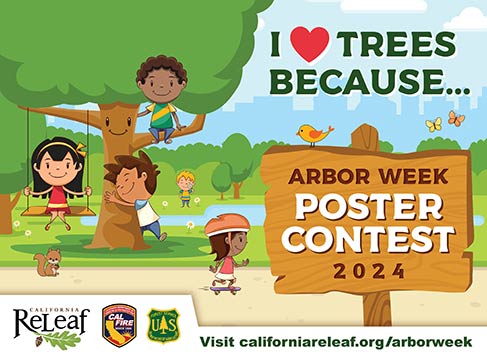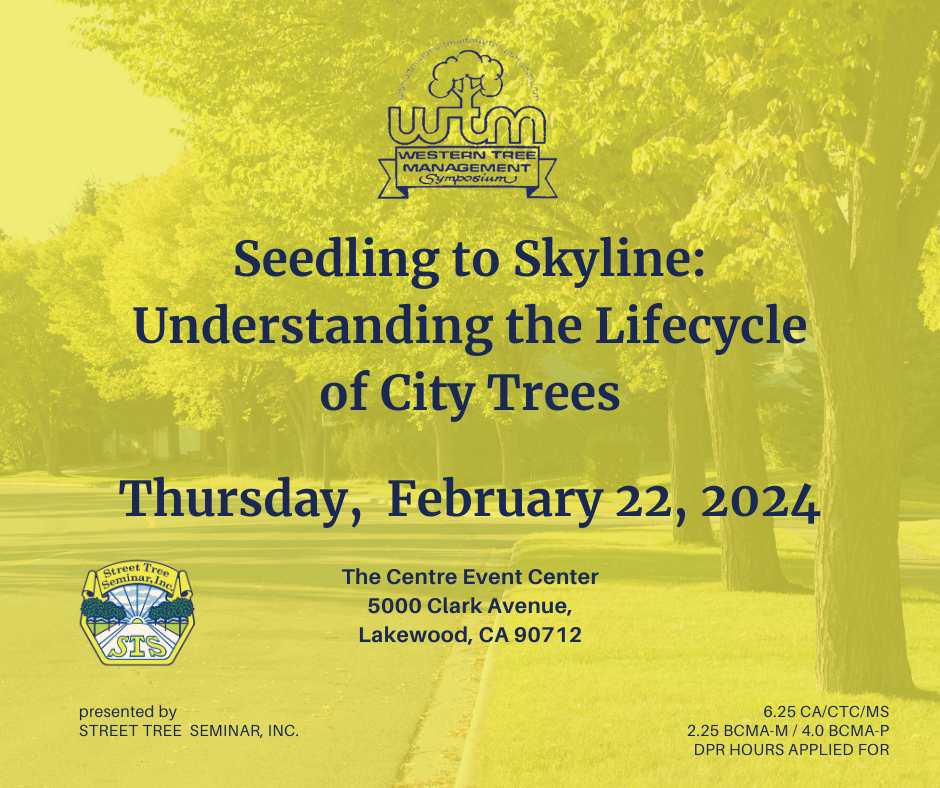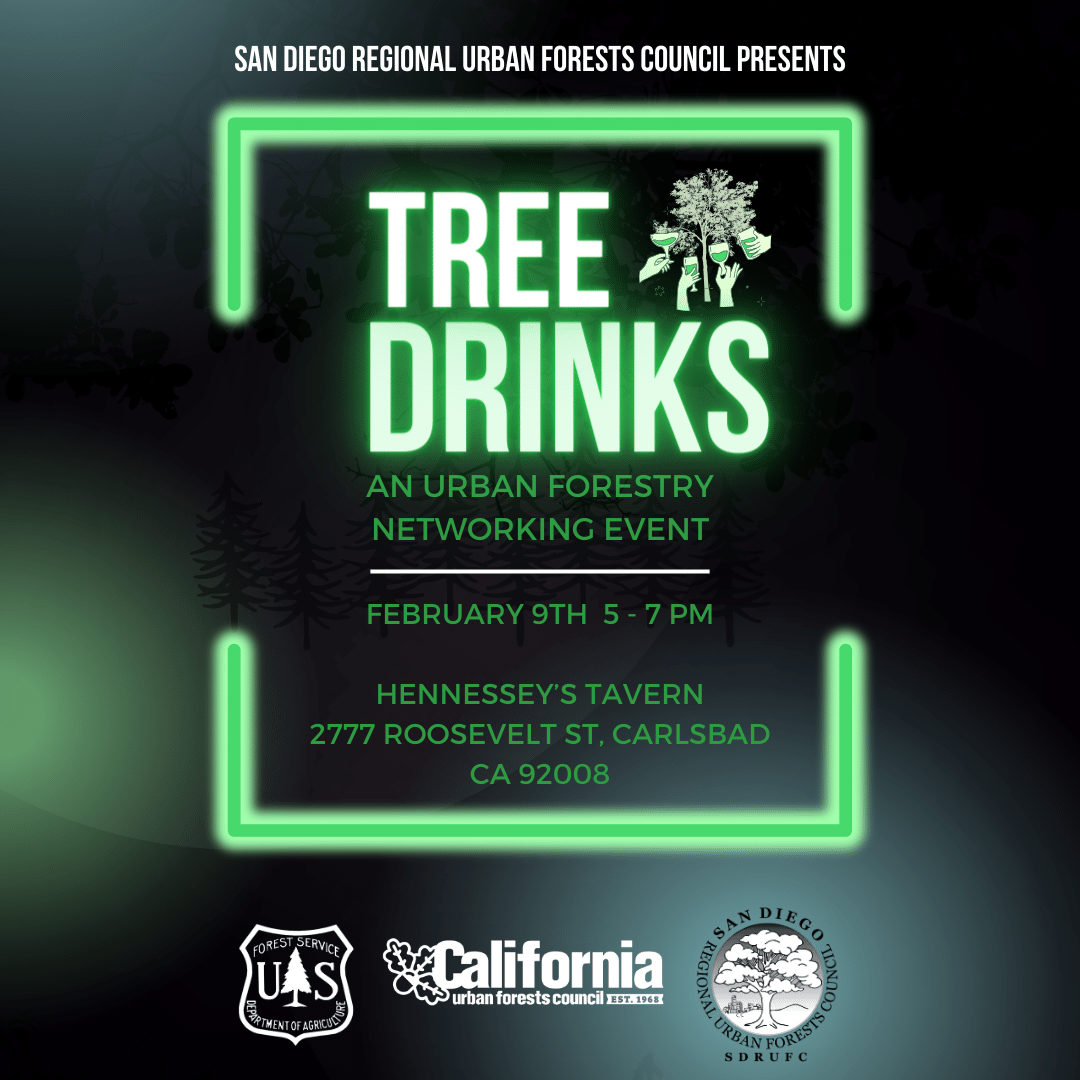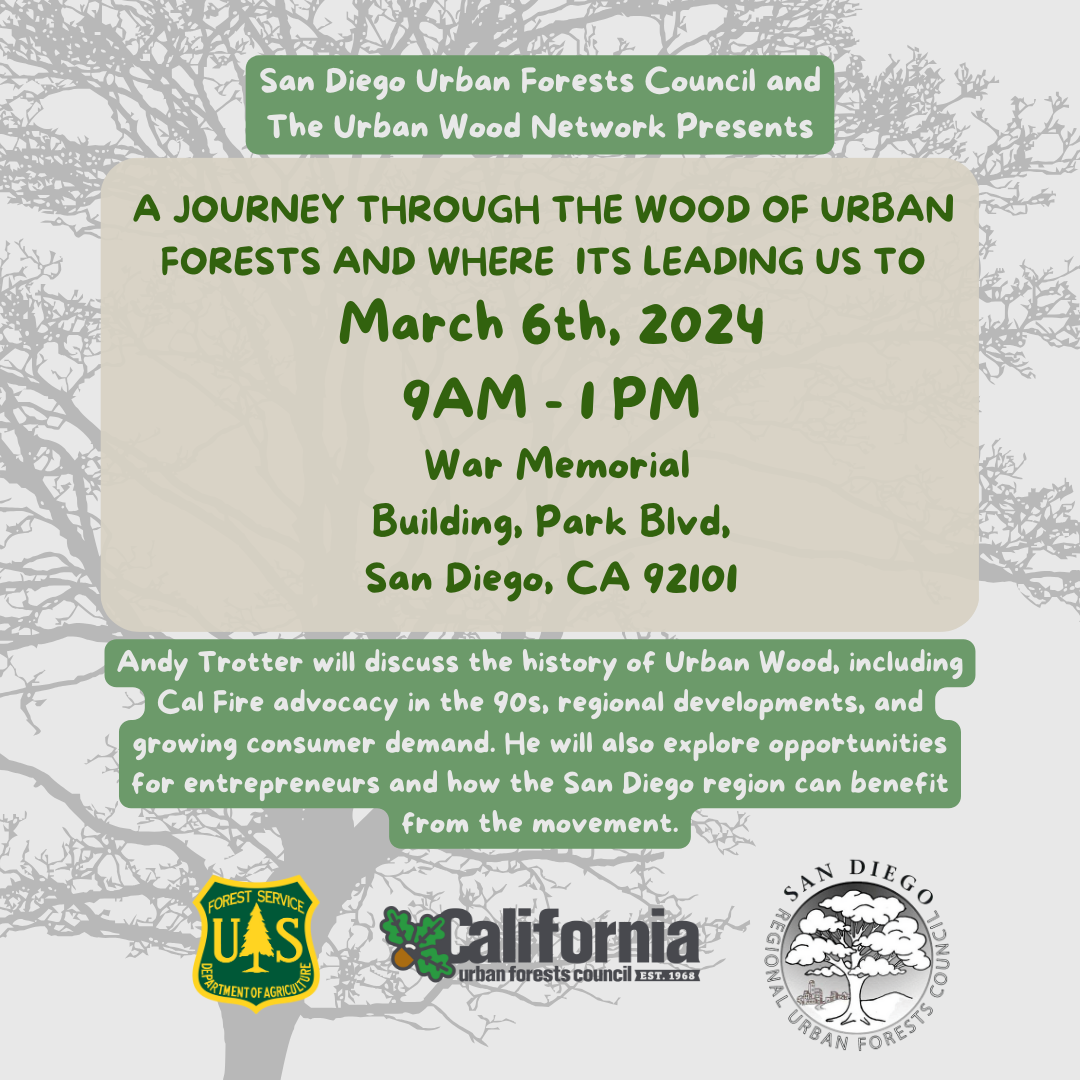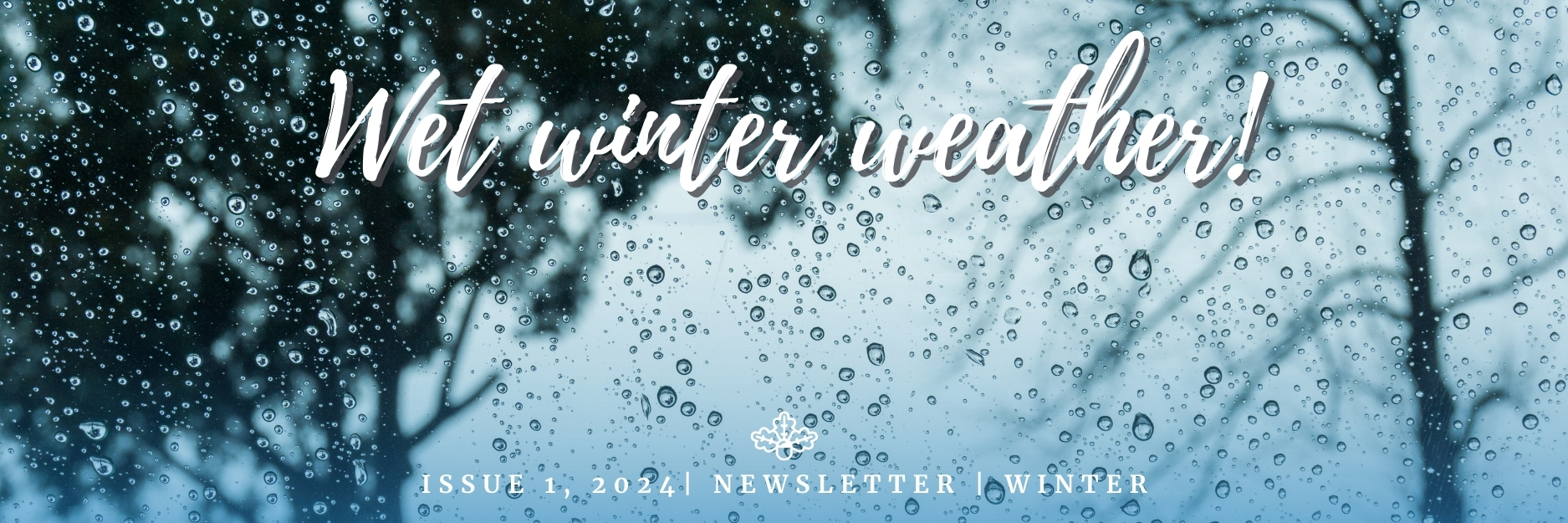

Greetings, fellow tree enthusiasts!
As winter graces California with its presence, we welcome the replenishment of our water resources. While some areas endure abnormal dryness, we’re fortunate that no counties currently face drought conditions. However, recent storms remind us of the unpredictable nature of California’s climate.
In light of these events, it’s crucial to recognize the invaluable role urban trees play in stormwater management. Properly maintained trees, especially those appropriately pruned, enhance community safety and resilience by reducing the likelihood of limb failure during storms. You can find some tips on preparing your trees for storms. Urban trees offer numerous benefits during storms, such as absorbing water, preventing erosion, slowing runoff, and filtering pollutants. Their extensive root systems stabilize soil, mitigating the risk of landslides and flooding. By intercepting rainwater and allowing it to percolate into the ground, trees alleviate pressure on stormwater infrastructure, contributing to overall water quality and conservation efforts.
In preparation for prolonged dry spells, we can cultivate water-efficient habits and address stormwater challenges. Personally, I’ve been observing water flow on my property during rainfall, exploring techniques to redirect runoff, and considering features like dry creek beds and rain gardens to mitigate stormwater runoff. My goal is to reduce supplemental water usage during summer. Valuable tips for preparing for the dry season ahead can be found on our website.
Amidst these considerations, urban trees not only provide shade during scorching summers but also play a crucial role in mitigating urban heat. A recent published paper by the team from Cal Poly at San Luis Obispo (Rendon, Love, Pawlak, Yost, Ritter, and Doremus) explores the relationship between biodiversity and cooling benefits in summer.
Did you participate in our haiku contest? Below, we feature the winning entries, and you can explore all submissions on your preferred social media channel(s). Additionally, for our youngest tree enthusiasts under 12, it’s time to unleash your creativity in California ReLeaf’s Arbor Week Poster Contest. Hurry, entries close on February 12!
Our regional councils are actively planning some exciting events. Street Tree Seminar is hosting the Winter WTMS, focusing on “Seedling to Skyline: Understanding the Lifecycle of City Trees.” The San Diego Regional Urban Forests Council is hosting Tree Drinks this Friday evening (February 9th), offering the perfect opportunity to mingle with like-minded nature enthusiasts. Every registered attendee will receive 1 Free Drink Ticket! In March, SDRUFC will host an Urban Wood Presentation led by Andy Trotter, delving into urban wood utilization and its sustainability impact.
We want to hear from you! How would you like to receive our newsletter? Let us know in our super quick poll.
Thank you for being an integral part of our community. Let’s continue to grow great communities and create a brighter and greener future for us all.

With gratitude,
Deb Etheredge
Communications Director
Welcome, Nate, our new ED!
CaUFC Gets New Executive Director & Address
LAGUNA BEACH, CA: Emina Darakjy, President of the California Urban Forests Council (CaUFC)
Board of Directors has announced the appointment of the organization’s new Executive Director. Nate Faris began his tenure with the organization in early January 2024. “I am confident in Nate’s ability to lead CaUFC into the future as the organization strives to build alliances as well as educate the public about the importance of trees,” said Darakjy.
Faris started his career in urban forestry in Indiana where he is credited with helping build the bones of Keep Indianapolis Beautiful’s tree planting and youth employment programs, doubling the size of that organization’s employees and volunteers. During his 14 years there, he oversaw the planting of more than 65,000 trees. Faris was also President of the Indiana Urban Forest Council where revenue was doubled and conference offerings were expanded. He has also worked in California in both the public sector as a municipal arborist and in the private sector as tree consultant. Faris is an International Society of Arboriculture Board Certified Master Arborist and an American Society of Consulting Arborists Registered Consulting Arborist. In 2018, he received the “True Professionals in Arboriculture” award from the International Society of Arboriculture for outstanding contributions to the field.
“I am honored to have this opportunity with CaUFC to collaborate with Californians to increase the quantity and quality of community trees and forests for the benefit of all” said Faris. “I look forward to continuing to build our relationships with CAL FIRE and the U.S. Forest Service, assisting them in meeting the missions of their urban and community forestry programs,” he continued.
Additionally, CaUFC has moved its offices from northern California to southern California, and will be headquartered in Laguna Beach. You can find our address under ‘Contact Us‘ on our website.
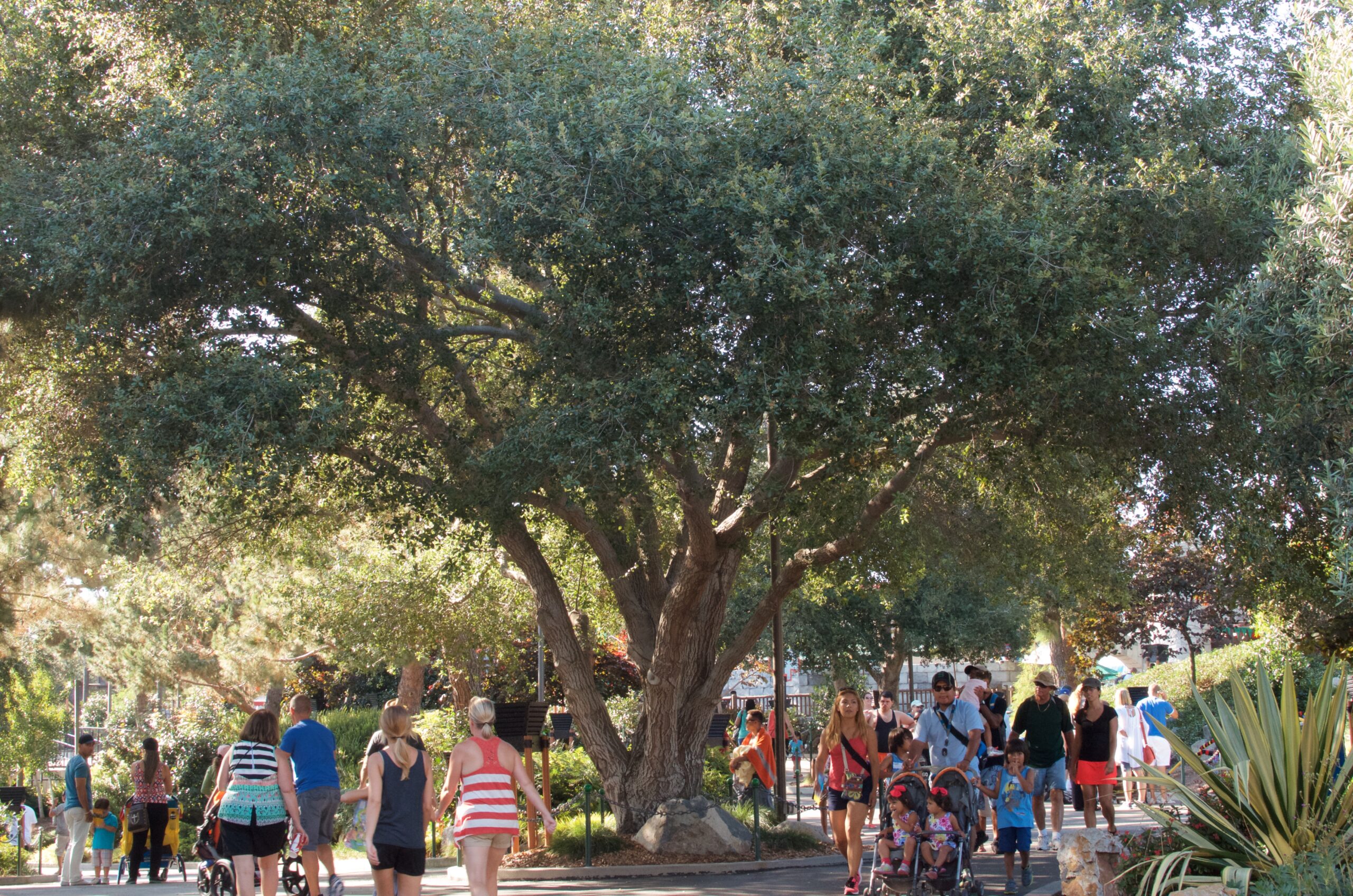
Quercus agriflora ‘Coast Live Oak’ by Jon Sullivan CC BY NC
Did You Know?
Quercus agrifolia is the native tree species most commonly found in urban environments within its native range in California.
Learn more about California’s native trees and their use in the urban forest
(Pawlak, Love, Yost, Fricker, Doremus & Ritter).
$20M in Grant Funding Available for OPR’s Extreme Heat & Community Resilience Program
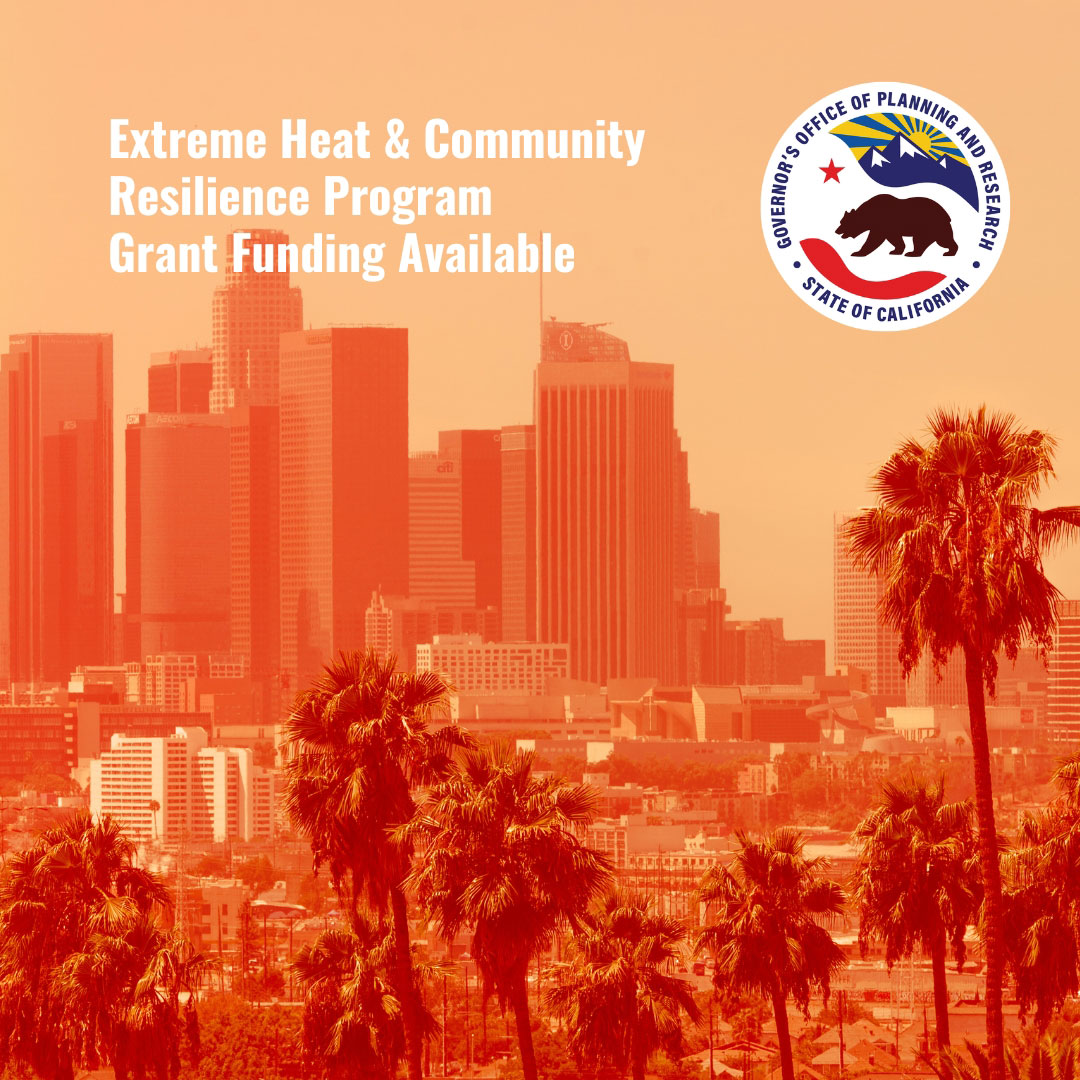
This program funds and supports local, regional, and tribal efforts to reduce the impacts of extreme heat. The Extreme Heat and Community Resilience Program coordinates the state’s efforts to address extreme heat and the urban heat island effect and has recently announced $20 million in grant funding.
Eligible Activities: The Extreme Heat and Community Resilience Program will fund various planning and implementation projects related to extreme heat and community resilience. Planning projects may include studies, the development of comprehensive extreme heat action plans or other planning documents, and capacity building and partnership development. Implementation projects could involve creating communication campaigns and programs, providing mechanical or natural shade, increasing building and surface reflectance, and developing passive or low-energy cooling strategies.
Eligible Applicants: Eligible applicants include local and regional public entities, California Native American tribes, community-based organizations, and coalitions, collaboratives, or associations of nonprofit organizations sponsored by a 501(c)(3) non-profit or academic institution.
See the Grant Guidelines to find out more.
Pre-Applications Interest Forms will be accepted on a rolling basis through April 23, 2024, at 5 P.M. PST. The Pre-Application Interest Form is required, and applicants will gain access to the Full Application Form only after completing it.
Applicants interested in being considered for Application Technical Assistance (TA) should submit the Pre-Application Interest Form as soon as possible and no later than March 5, 2024, at 5 p.m. PST.

Haiku Contest Winners!
Did you enter our haiku contest in 2023? The theme was ‘Shades of Well-Being: Urban Forestry’s Role in Public Health & Equity.’ We received a hundred entries from five countries and fifteen US states! It’s wonderful to see the enthusiasm of tree lovers worldwide.
Entrants were tasked with poetically capturing the essence of urban forestry’s impact on public health and equity in just three lines.
Below are the winning entries:
1st: Jonathan Aylett
2nd: Goran Galatica
3rd: Kelly Shaw
To view all the entries, check out our social media channels: Facebook, Instagram, X (Twitter), and LinkedIn.
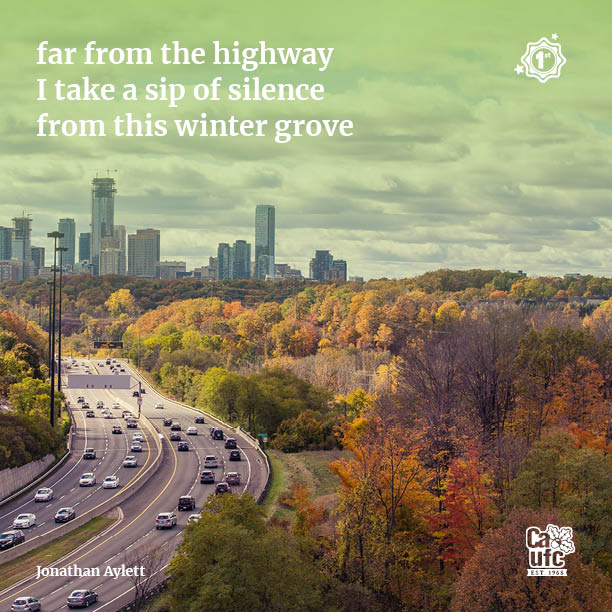
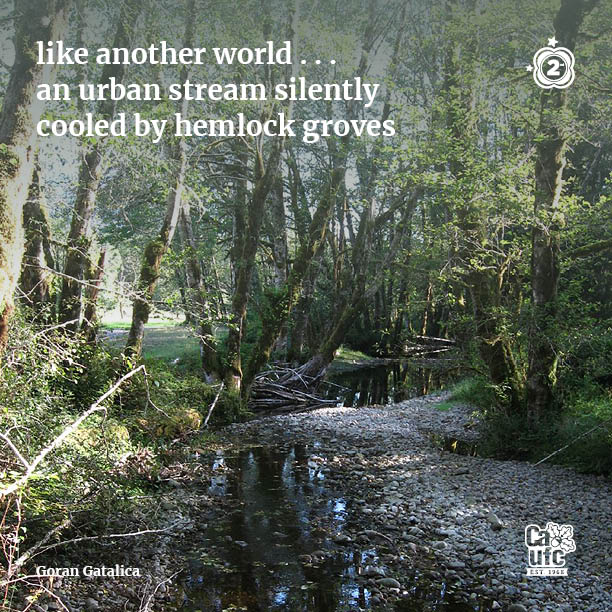
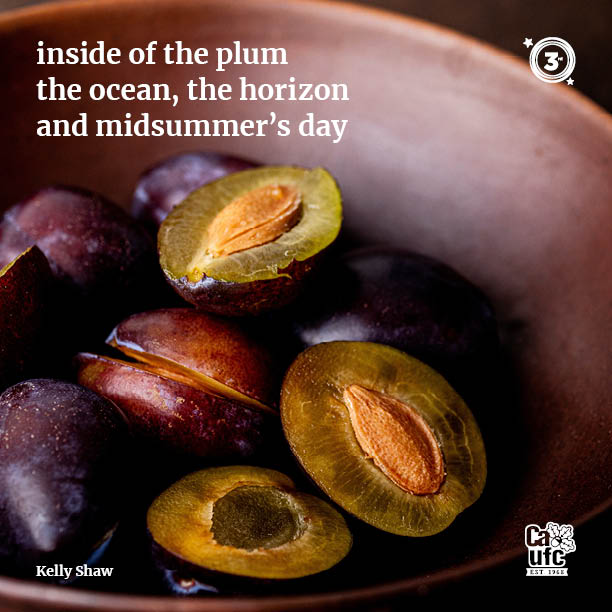
2024 Arbor Week Youth Poster Contest
Attention Young Artists! Every year, our friends at California ReLeaf kick off Arbor Week (March 7 – 14) with a Youth Poster Contest. Arbor Week is a time to celebrate how trees make our neighborhoods cooler, healthier, and safer for everyone. Join the celebration! We invite California youth ages 5 – 12 to creatively express their love and knowledge of trees through art. This year’s theme is “I ❤️ Trees Because…” Enter to Win Cash Prizes! Entries are due by February 12, 2024. For guidelines, entry forms, and more information, visit the website. You can also download the flyer here.
Upcoming Events
Looking to deepen your knowledge and connection with the world of urban forestry? Look no further—upcoming events are here to provide you with exciting opportunities to engage, learn, and grow.
Events
Join the Street Tree Seminar as they meet at a new venue, the Centre in Lakewood, for the Winter 2024 Western Tree Management Symposium on Thursday, February 22.
Speakers will present on a range of topics, including:
- A Look at New Tree Species & Nursery Techniques
- Young Tree Pruning
- Mulch: A 30-Year Research Retrospective
- Thoughts on Tree Appraisal, the 10th Edition, and the Regional Plant Appraisal Guide
- A300 Pruning Standard Consolidation Overview & Outdoor Field Session
- Up and Coming Tree Problems in Southern California –
Foes we may know and some we may not
Lunch is included. 5.75 CEUs available
Download the flyer or visit the website to find more events.
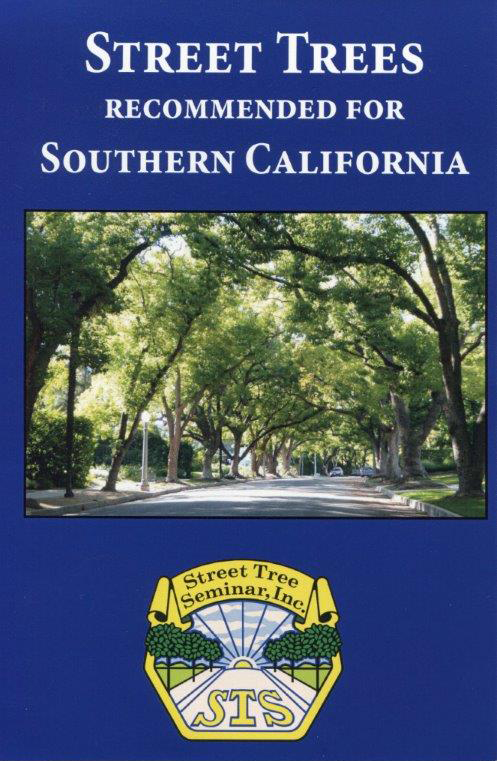
Brush up on your local trees!
Order your copy of the 3rd Edition of “Street Trees Recommended for Southern California“!
San Diego tree lovers, this one is for you, from our regional council.
Join the San Diego Regional Urban Forests Council on February 9 from 5 to 7 PM at Hennessy’s Tavern in Carlsbad. It will be a night of fun conversation, networking, and getting to know your local tree stewards! All are welcome.
Date: February 9 Time: 5 to 7 PM Where: Hennessy’s Tavern in Carlsbad – Front Patio Every attendee who RSVPs will receive 1 free drink ticket. To RSVP click here.Unveiling the Ginkgo Biloba:
A Tree of Enduring Beauty & Resilience
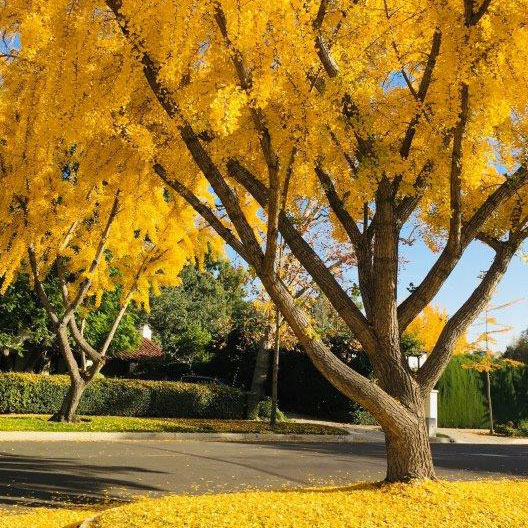
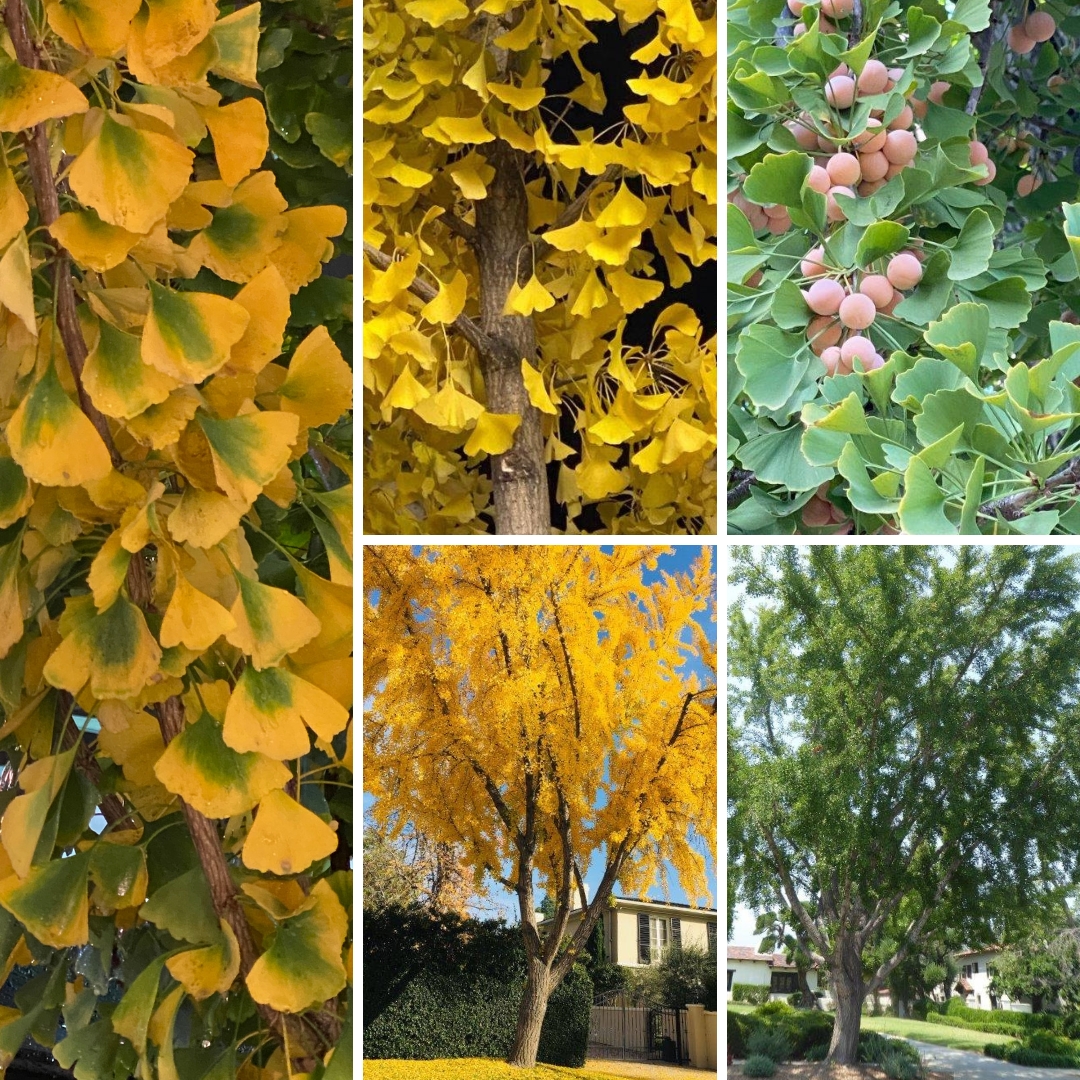
© Article & Photographs by Emina Darakjy
Ginkgo biloba, also called Maidenhair tree
Family: Ginkgoaceae
Origin: Southeastern China
This is a tall deciduous tree, slow growing, it can reach a height of 50 to 80 feet and a spread from 25 to 40 feet.
When the tree is young the trunk bark is light gray becoming darker with irregular furrows as the tree matures. The leaves are flat and fan shaped, they start bright green in the summer turning to yellow in the fall before dropping like brilliant golden snowflakes carpeting the ground underneath. It is a beautiful sight to see.
The ginkgo flowers are unnoticeable and fragrant. The female variety produces fruit that looks like small plums that drop when ripe and has a foul smell when crushed by people walking on it. It can also cause a slip hazard. To avoid this nuisance, make sure you plant only male grafted cultivars. The fruit is however considered a delicacy in the Orient where the inside seed is roasted before it is consumed.
The Ginkgo adapts to any soil conditions, withstands air pollution, is drought tolerant, grows in partial shade but does better in full sun and is not recommended underneath power lines.
The Ginkgo can be found as a street tree, in medians and in parks. When given ample room to grow the tree exhibits wide spreading branches. If space is tight, try and plant something called “Fairmont” which grows in a conical form OR the “Princeton Sentry” which has an even narrower column like shape.
The Ginkgo does not require a lot of maintenance, it can benefit from some light spring pruning when young but hardly needs any when mature, does not have any significant known pest problems and is resistant to oak root fungus.
It is worthy to note that the Ginkgo is considered as one of the oldest living trees. Research and fossil records show that the Ginkgo existed during the Jurassic period millions of years ago.
Registration coming Early 2024
Keynote speaker – James Clark, PhD
The conference theme “Cultivating Competence” operates on at least two levels, organizational and personal. At both levels we want to develop and nurture the skills and abilities need to perform the tasks required of an arborist. Programs like Certified Arborist, Certified Tree Climber, TRAQ, and CTSP connect the individual and organization. Dr. Clark will argue that these programs are necessary to cultivate competence but not sufficient to achieve it. Join the WCISA in May for this provocative discussion! Registration opens soon. Click here for more information.
“In every seed lies
the promise of forest.”
~ Deepak Chopra


Career Opportunities:
- Tree Care Specialist
- Urban Forestry Manager
- Development Manager
- Landscape Architect/Project Manager
- Youth Environmental Stewards
- Project Manager II
- Internship
- Community Forestry Apprentice
- Community Forestry Associate
- Green Infrastructure Coordinator
- Billing Accountant
- Chief Financial Officer
- Mountain Forestry Program Manager
- Mountain Forestry Coordinator
- Mountain Reforestation Associate Program Manager
- Park Maintenance Associate
- AmeriCorps Member – Planting Resilience
- Forestry Administration Coordinator
- Green Infrastructure Coordinator
- Climate Action Director
- Business Support Officer
- Climate Corps Service Member
- Volunteer Engagement Coordinator
- New Roots Participant
- Adult Education Coordinator
- Communications and Marketing Coordinator
- Environmental Educator
- Cool Schools Yolo Engagement Manager
- Cool Schools Yolo Education Coordinator
- Tree Trimmer II
- Arborist Lead Worker
Roseville Urban Forest Foundation:
- Community Forester (Part-time)
- Urban Forestry Inspector
Koreatown Youth and Community Center:
- Environmental Services: Urban Forestry Lead
Here are the most popular posts we shared on Facebook last season.
- The World’s Oldest Forest Has 385-Million-Year-Old Tree Roots
- Saving the American chestnut: A story of renewal, regrowth and hope
- Trees, and Other Entanglements
- California native plants are not our only choice for drought-tolerant landscapes
- California’s drought is over, but forests are still dying. What’s happening?
- Government should target tree aftercare rather than planting, say UK experts
- The Incredible Connection Between Consumer Loyalty And Climate Responsibility
- California’s prized redwood forests are going extinct: ‘We’re losing them at a rate that is something that we can’t sustain’
- How America Is Making Tree Equity a Climate Solution for Cities



